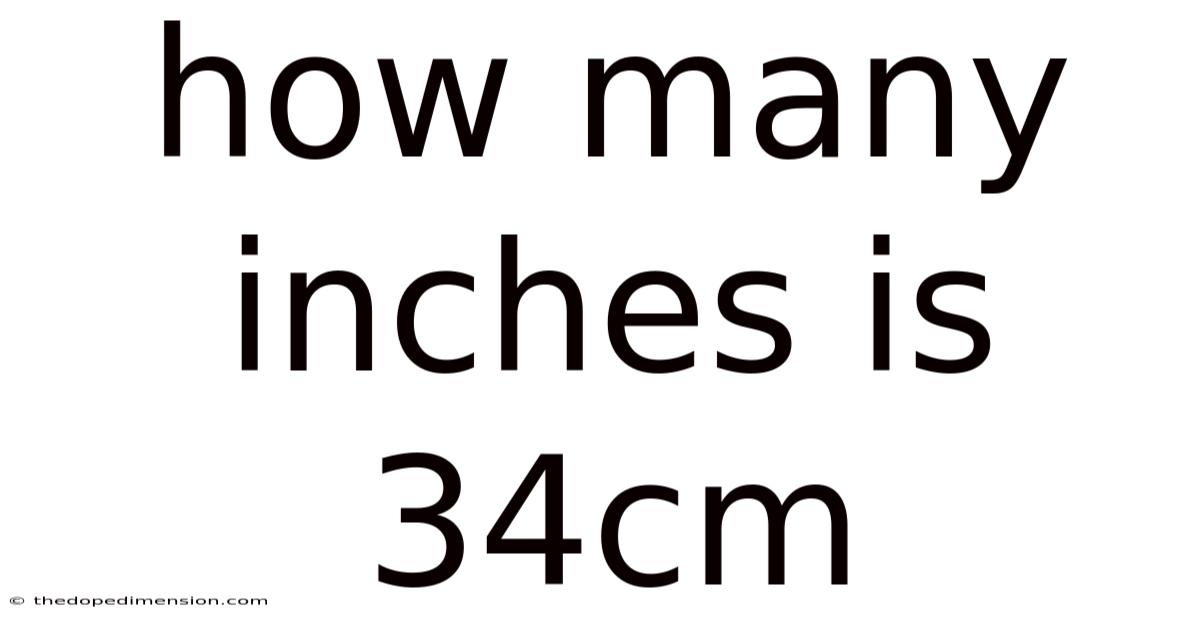How Many Inches Is 34cm
thedopedimension
Sep 11, 2025 · 4 min read

Table of Contents
How Many Inches is 34cm? A Comprehensive Guide to Metric-Imperial Conversions
Knowing how to convert between metric and imperial units is a crucial skill, especially in a globalized world. This seemingly simple question – "How many inches is 34cm?" – opens the door to understanding the fundamental principles of unit conversion and the practical applications in various fields. This comprehensive guide will not only answer this question but also delve deeper into the intricacies of metric-imperial conversions, offering a wealth of information for anyone looking to master this essential skill.
Understanding the Metric and Imperial Systems
Before diving into the conversion, let's briefly understand the two systems involved:
-
Metric System (International System of Units or SI): This system is based on powers of 10, making conversions relatively straightforward. The fundamental units are meters (length), kilograms (mass), and seconds (time). Centimeters (cm) are a common unit of length, representing one-hundredth of a meter.
-
Imperial System (or US Customary Units): This system is more complex, lacking the consistent decimal relationships of the metric system. It uses inches, feet, yards, and miles for length, pounds for mass, and seconds for time. The relationships between these units are often irregular (e.g., 12 inches in a foot, 3 feet in a yard).
Converting 34cm to Inches: The Calculation
The conversion factor between centimeters and inches is approximately 2.54 centimeters per inch. Therefore, to convert 34 centimeters to inches, we perform the following calculation:
34 cm / 2.54 cm/inch ≈ 13.39 inches
Therefore, 34 centimeters is approximately 13.39 inches.
Beyond the Basic Calculation: A Deeper Dive into Conversion Methods
While the above calculation provides the answer, understanding the underlying principles will empower you to convert any metric length to imperial units and vice versa. Here are some methods:
1. Direct Conversion Using the Conversion Factor:
This is the most straightforward method, as demonstrated above. Simply divide the value in centimeters by 2.54 to get the equivalent value in inches. For example:
- 10 cm / 2.54 cm/inch ≈ 3.94 inches
- 50 cm / 2.54 cm/inch ≈ 19.69 inches
2. Using Proportions:
This method is useful for understanding the relationship between the units. We can set up a proportion:
- cm / inches = 2.54 cm / 1 inch
Let's use this to convert 34cm:
- 34 cm / x inches = 2.54 cm / 1 inch
Solving for x:
- x inches = 34 cm * (1 inch / 2.54 cm) ≈ 13.39 inches
3. Employing Online Converters:
Many online tools are available to perform these conversions instantly. While convenient, understanding the underlying calculations is crucial for accuracy and problem-solving in scenarios without internet access.
Practical Applications of Metric-Imperial Conversions
The ability to convert between metric and imperial units is invaluable in many fields:
-
Engineering and Manufacturing: International collaboration requires seamless conversion between unit systems to ensure precise measurements and avoid errors.
-
Construction and Architecture: Blueprint readings and material specifications may use different unit systems.
-
Medical Field: Accurate medication dosages and patient measurements often require conversion.
-
Scientific Research: Data analysis frequently involves converting units to ensure consistency and comparability across studies.
-
Everyday Life: Understanding unit conversions is helpful for tasks like cooking (following recipes with different units), sewing (converting pattern measurements), and travel (navigating distances indicated in different units).
Frequently Asked Questions (FAQ)
Q: Why is the conversion factor 2.54 cm/inch?
A: The conversion factor is based on the internationally agreed-upon definition of the inch relative to the meter. It's not a randomly chosen number but a precisely defined constant.
Q: Are there any other useful conversion factors?
A: Yes! Knowing other conversions is extremely helpful:
- Inches to feet: 1 foot = 12 inches
- Feet to yards: 1 yard = 3 feet
- Yards to miles: 1 mile = 1760 yards
- Centimeters to meters: 1 meter = 100 centimeters
- Meters to kilometers: 1 kilometer = 1000 meters
Q: How can I improve my accuracy in conversions?
A: Using a calculator with sufficient decimal places ensures greater precision. Also, double-checking your calculations and understanding the context of the measurement is essential.
Q: What if I need to convert more complex units, like square centimeters to square inches?
A: For area conversions, you need to square the linear conversion factor. Since 1 inch is approximately 2.54 cm, 1 square inch is approximately (2.54 cm)² ≈ 6.45 square centimeters.
Q: Why are both metric and imperial systems still in use?
A: The transition to a fully metric world has been gradual and incomplete in some regions, particularly the United States. Historical factors, costs of complete conversion, and ingrained habits contribute to the continued use of both systems.
Conclusion: Mastering Unit Conversions
Converting 34cm to inches is more than just a simple arithmetic problem; it's a gateway to understanding the fundamental principles of unit conversion and their practical applications in various fields. By mastering these principles, you'll be equipped to navigate a world where both metric and imperial units coexist, enhancing your problem-solving abilities and contributing to more accurate and efficient work in various disciplines. Remember, consistent practice and a thorough understanding of the underlying conversion factors are key to success. Embrace the challenge, and you'll find yourself confidently converting units in any situation.
Latest Posts
Latest Posts
-
1 Square Meter To Acre
Sep 11, 2025
-
3l Is How Many Quarts
Sep 11, 2025
-
25 000 Minutes To Days
Sep 11, 2025
-
130 000 Minutes To Days
Sep 11, 2025
-
How Long Is 50 Yards
Sep 11, 2025
Related Post
Thank you for visiting our website which covers about How Many Inches Is 34cm . We hope the information provided has been useful to you. Feel free to contact us if you have any questions or need further assistance. See you next time and don't miss to bookmark.